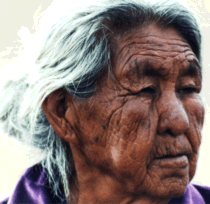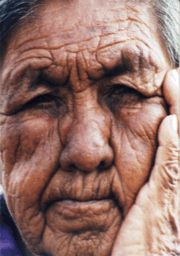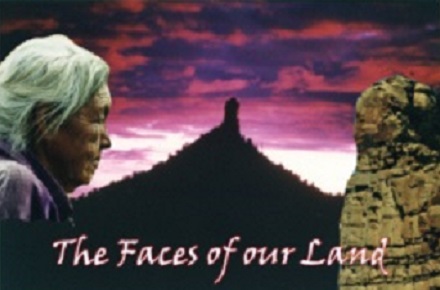In 1889 Wovoka, a Paiute Holy Man, had a vision from God. In the vision God had told him that a time would come when all things would be restored. The buffalo would once again run across the planes, the people would be able to live in peace once again; the dead will live once again and there would be no more suffering forever.
The message of the vision spread rapidly throughout what was left of the Indian Nations. Tribes and bands, which heard of the vision, began to hold prayer meetings. Some of these prayers would go on for days at a time. Most of the people at this point in time were barely clinging to life. Word of the vision and prayers birthed a spirit of hope for a future among the People. The Indians thought the killing was over and that it was a time to gather for things like prayer. In December of 1890 Many Indians began gathering in South Dakota at a place called Porcupine Creek for the ceremonial prayer, it was known as the "Ghost Dance." There were few reservations at the time. Forced off of their birth lands by settlers, the Indian people were pushed north west to unusable barren land. The reservations that had been established were like shanty that had nearby forts with full time soldiers, who for the most part despised them.
In the late 1800'S Indian children on reservations were taken away from their parents and put into boarding schools so they could be taught to act and live like American people. The children were not allowed to speak their native language, their hair was cut in the style of the American children's hair and then they were dressed in American children's clothing.
There are accounts of many these children being severely beaten for trying to escape and return to their families on the reservations. One of these schools called Pine Ridge was located 30 miles away from Porcupine Creek where the Ghost Dance was being held. Just after dark on the night of December 24th, 50 boys the average age of ten, led by an older boy named Dewy Beard who knew about the gathering at porcupine creek, escaped from Pine Ridge. They ran all night and arrived safely at the Ghost Dance by sun-up the next morning.
Off in another direction, Christmas day at the Cheyenne River Agency in South Dakota, Sioux Chief Big Foot, known for being peaceful, gathered the remainder of his people. Consisting of 106 men mostly elderly, all hungry and many sick, 252 woman and children. They headed toward Porcupine Creek to join the Ghost Dance. Big Food was old and Sickly himself but that was even more reason to make it to the prayer gathering. After a day of hard traveling in the cold winter weather, Big foot and his people stopped by a creek near Pine Ridge to camp. No sooner then the band set up camp they were surrounded, some yards out, by hundreds of troops from the seventh Calvary. The troops were armed with heavy artillery including gatling guns and rapid-fire canons. Big foot immediately had all of his people to gather anything even resembling a weapon and pile it all in front of his tent. On the front of his tent he hung a medal of peace awarded to him years before by President Lincoln. He did this so that the soldiers would know that they were peaceful, unarmed, under a treaty and not enemies there to fight.
The soldiers spent the evening drinking hard liquor mixed with loud talk. No one knows what Big Foot might have been thinking. Just before the dawn broke across the horizon the soldiers opened fire with everything they had. Women were desperately gathering the children and trying to run away as soldiers would ride after them shooting each woman and child several times even after they were already dead.
After the smoke cleared only a few women and children were left alive and they laid hiding in the snow as though they were dead. The Commander of the seventh Calvary called out for all the remaining Indians to show themselves, that the shooting was over and the rest of them would go unharmed. Approximately 100 women and children stood up. Immediately the soldiers opened fire killing half of them and wounding the rest.
At the end 49 wounded women and children were all that remained of Big Foot's people. They were piled into a wagon and taken to the fort where they were gathered into the fort chapel. On the entrance of the Chapel hung a large holiday banner reading "Peace on Earth and Good Will Toward all."
A news reporter named Thomas Tibble, who witnessed and recorded the event, begged the fort surgeon, who had worked on the battlefields of the Civil War, to look after the wounded Indians. The surgeon was sickened by what he saw and Tibble reported him saying that in all of the bloody war years he never saw so many women and children shot-up as the ones in that room.
Near blizzard conditions had set in so it was three full days before anyone would ride back to the scene. When they arrived Big Foot's body was frozen in a half sitting up position, one arm reaching up with his medal of peace clinched in his frozen hand. As they were piling bodies in the pit one soldier noticed a moving pile of blankets. Under the blankets they found a baby girl alive and unharmed. They dug a huge pit to put the dead bodies of the Indians in and took the baby back with them.
This event is known as Wounded Knee. Many claim that the hostile Indians shot first at this massacre, however the news reporter, an eye witness, recorded a version more like the one you just read. History calls it "One of the last Great Indian Battles." The Indians know it as the Wounded Knee Massacre. Below is a link to copies of some of the original photographs taken at the scene.



